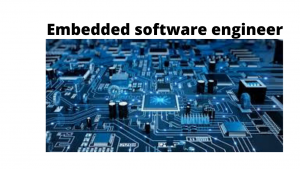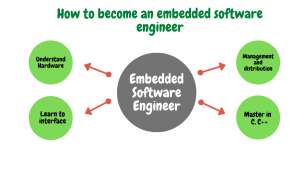Embedded software engineer
Who is an embedded software engineer?
In particular, Embedded Software Engineers are responsible for developing embedded devices and operating systems. Furthermore, they would be able to assess and control the system’s performance and performance. The very first layer of programming that runs on a computer is embedded software. Dream about a PC ‘s Firmware. Embedded engineers execute scripts, but they do need a thorough understanding of the equipment it operates on, like software engineers. Any embedded engineer is familiar with hardware templates and also how device datasheets apply to the programming code for devices. Typically, embedded software is self-contained and operates even a single programme. As a result, embedded software engineers decide the shortest practical number of drivers to update the application that the system requires. These have embedded applications for almost everything, from toasters and light bulbs to wearables, electronic TVs and associated electronics in vehicles. Broadly speaking, we do not even conceive of these machines as computers, but they do have fundamental technology that allows them to work. That’s where you’ll be developing as an embedded software engineer. Software engineers and computer scientists are at the crossroads of the discipline.

Figure.1
Do you need a embedded software engineer for your projects. Then get in touch we can help with your requirements.
How to become an embedded software engineer?
One of the very first factors to consider whether you’re involved in being an embedded software engineer is just how much training you want. 45.1 percent of embedded software engineers have such a bachelor’s degree. Researchers discovered that 48.4 percent of embedded software engineers have master’s degrees with regard to higher educational levels. You have to protect your bases, firstly. To embedded software engineers, understanding C as a programming language is a necessity. One of the most successful programming languages is known to still be C. Irrespective of what area or industry you work in, you’re definitely going to work with C.
C and C++ Master
You have to cover the bases, so once again. For embedded software developers, mastering C as a programming language is a necessity. One of the most successful programming languages is known to be C. Regardless of what area or industry you work in, you’re definitely planning to happen with C.
Understand hardware and its components
it is important to understand how well the hardware you write code for is necessary. You won’t have the luxury of just trying out the software as an embedded software engineer. The probability that something might be incorrect with the hardware would still have to be weighed, too. You will know how the hardware works or why it does stuff in some ways to define and repair
Learn to interface & create your favourite circuits for breadboards
Begin with such a small package centred on the 8051 Microcontroller. In the sector, there seem to be a lot. Choose one. Create the kit with C and Assembly code and run with that as well. Recognize why it functions the way that it does, rather than having the performance you like. I would say that first by having something that does not function properly, you can understand more. You’re able to go through to the next level with C and Micro-controller programming underneath your belt-constructing anything and learning from it. Microprocessors are computational engines that you algorithmically monitor. They have certain basic components inside them, such as a timer, power cable, small memory, etc. But there is virtually nothing you can do with only a microcontroller. You even have to Connect Any Device for simple user interaction.
Management and distribution of Master Capital
A large part of your work as an embedded software engineer would be struggling with various constraints. You’ll have had to worry about how much of your embedded system’s underlying hardware is used. That involves loops of RAM, ROM and Processor. They must be used as effectively as possible and delegated to the right positions. It is crucial in this area of work to balance out the advantages and disadvantages and to recognise the most difficult jobs.

Figure. 2
The role of embedded software in IOT
An MS in Embedded Systems can make you highly appealing to Internet of Things (IoT) businesses. Organizations allow historically analogue mechanical devices to be linked to the ‘cloud’ and individuals who can support develop and execute technologies that allow this to be profitably compensated. For both the embedded sector, the growth potential is immense. And each day, the way forward has become easier. It’s time for us to start developing IoT systems as well as provide our clients with value. The Internet of Things (IoT) is no longer a vision that is fanciful. With everything from automation systems to on-demand entertainment, it is very much with us. With such a high degree of quality to particular specifications, IoT solutions largely would have to be designed from development, which has pushed increase the price and difficulty of production and dissuaded many potential market entries. What has been lacking are development tools that mitigate the costs related to the development of the fundamental framework, the “plumbing” of their applications, so that they can concentrate on improving the core features and get alternatives with less expense to the market faster. These problems are addressed by transfer Technology with emerging innovations which have the potential to broaden the IoT market by cutting the price and sophistication of production.
What does a good engineer of embedded software make?
In our view, it is important to offer an entire device viewpoint to the focus on the core software developers. They need to grasp the low-level principles as to how the software communicates to the physical infrastructure. But they need to recognize the hardware they’re operating on, such as the numerous system-connected peripheral devices. Problem solving is a major part in embedded software development. Embedded developers must be able to identify problems and fix them, although time and cost are minimally depleted. The ambiguity typically does not lie in the code lines in embedded applications. It falls from customer requirements and contemporary issues that emerge throughout development. We also address issues that hardware engineers are not aware of or are unable to solve, for instance. In general, that’s the case with existing equipment, which can be assumed to be fixed or costly.
Read more about this.